Shani G. Radiation Dosimetry: Instrumentation and Methods
Подождите немного. Документ загружается.

CH-07.fm Page 360 Friday, November 10, 2000 12:03 PM

361
8
Solid-State Dosimeters
CONTENTS
I. Diamond Dosimeter ............................................................................................................................................361
II. MOSFET Radiation Dosimeter...........................................................................................................................372
III. P-Type Semiconductor Dosimeter ......................................................................................................................381
IV. Other Solid-State Dosimeters..............................................................................................................................391
References .......................................................................................................................................................................399
I. DIAMOND DOSIMETER
Diamond detectors are attractive for high-resolution mega-
voltage photon and electron beam measurements because
of their small size and near tissue equivalence (
Z
6
compared to
Z
eff
7.42 for soft tissue). Diamond detectors
work as solid-state ionization chambers. The absorption of
ionizing radiation induces a temporary change in the elec-
trical conductivity of the diamond through the production
of electrons and positive holes that have sufficient energy
to be free to move through the crystal. They have dimen-
sions and spatial resolution similar to commonly used sil-
icon diode detectors, and they are almost tissue-equivalent.
Other advantages include high sensitivity, low leakage cur-
rent, and high resistance to radiation damage. Diamond
detectors can be considered resistive elements where, for
a given bias voltage, the current is zero with no radiation
and increases almost linearly with dose rate. For a given
dose rate, current is nearly proportional to bias voltage.
The response of the diamond detector has been shown to
be nearly independent of the incident photon energy, since
the mass attenuation coefficient ratio of water to carbon is
nearly constant.
In a pure crystal, recombination quickly neutralizes the
ion pairs produced. Nitrogen atoms are generally present
as an impurity in the diamond crystals. After bonding
covalently with the carbon atom, the nitrogen atom is left
with an unpaired electron, which has a high probability
of jumping to the conduction band. The ionized impurity
created acts as a trap for electrons generated during elec-
tron-hole pair production. The free electrons captured in
the ionized trap produce polarization, thus reducing the
electric field generated by the external
100-V bias. As
the diamond detector is irradiated, its response initially
decreases due to an increase in the polarization effect. The
detector response is finally stabilized when an equilibrium
trap population is attained.
The suitability of a natural diamond detector with a
special contact system for the measurement of relative
dose distributions in selected radiotherapy applications
was studied by Vatnitsky and Jarvinen. [1] A natural dia-
mond plate of 0.2–0.4-mm thickness and with the special
contact system was positioned inside a cylindrical plastic
capsule at a depth of 0.2 mm for detector Dl, 0.3 mm for
detector D2, and 1.0 mm for detector D3; see Figure 8.1.
The material of the capsule was PMMA (Dl, D2) and
polystyrene (D3). The front window of detector Dl was
transparent, while the windows of detectors D2 and D3
were opaque to light. The detector bias was 250 V (Dl),
150 V (D2), and 100 V (D3). After switching on the high
voltage, a pre-irradiation of the detectors up to a dose of
about 2 Gy (Dl) and 3Gy (D2, D3) was performed to settle
the response of the diamond to a stable level.
The variation of the stopping-power ratio (water/mate-
rial) as a function of electron energy for the three detector
materials is shown in Figure 8.2.
Diamond detectors are radiosensitive resistors whose
conductivity varies almost in proportion to dose rate and is
almost independent of bias voltage for a constant dose rate.
At the recommended bias of +100 V, and also at +200 V,
the detector is operating with incomplete charge collection
due to the electron-hole recombination time being shorter
than the maximum time for an electron to be collected by
the anode. As dose rate is varied by changing FSD or depth
(changing dose per pulse), detector current and dose rate
are related by the expression
i
D
, where
is approxi-
mately 0.98. This manifests itself in an overestimate in
percentage depth dose of approximately 1% at a depth of
30 cm when compared to ionization chamber results. The
dose rate dependence is attributed to the reduction in
recombination time as dose rate increases. [2]
The recombination rate in a pure crystal (when an equi-
librium number of free electrons is established) is propor-
tional to the square root of the rate of ion-pair production
Ch-08.fm Page 361 Friday, November 10, 2000 12:03 PM
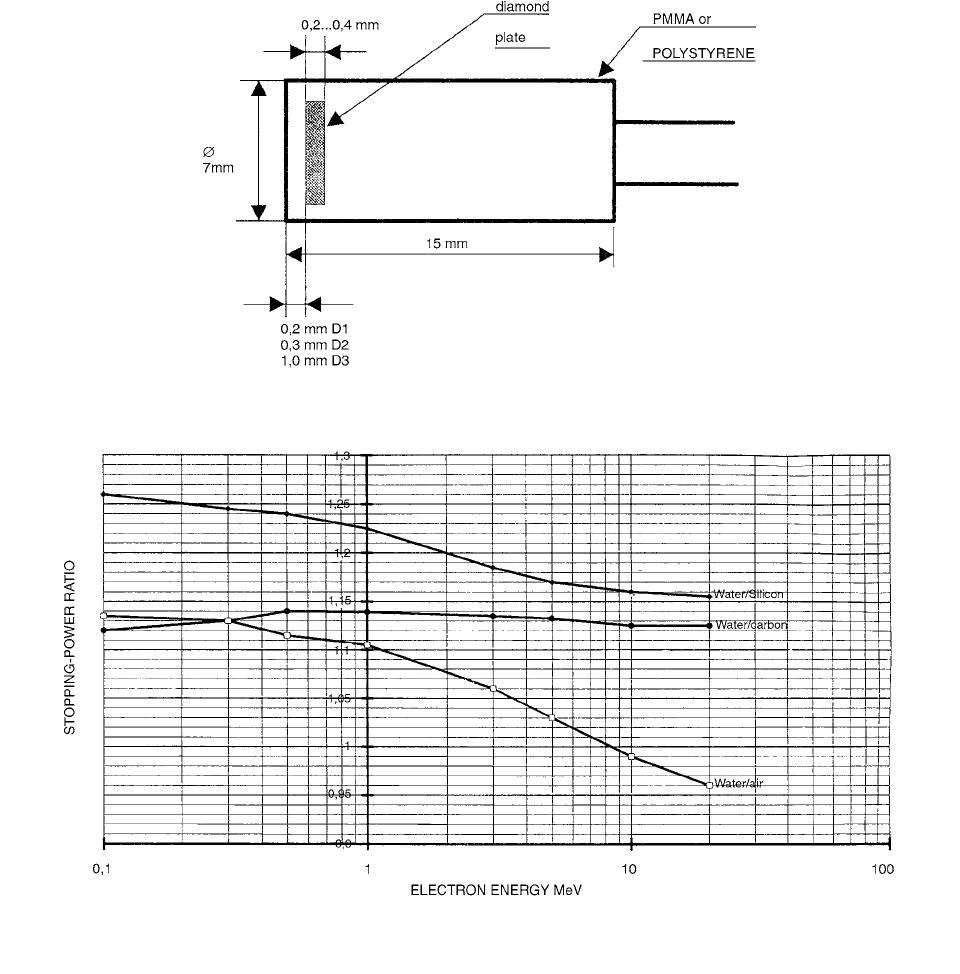
362
Radiation Dosimetry: Instrumentation and Methods
and, hence, to the dose rate. This is due to the increase in
the probability of recombination with the number of vacant
holes. Charge-collection efficiency therefore decreases with
dose rate, making a pure crystal unsuitable for dosimetry.
If impurities are present, metastable states are introduced
which trap many electrons that would otherwise recom-
bine with holes. If the number of electrons in traps is large,
the proportional increase in the number of vacant holes
can be almost independent of dose rate. This means that
the recombination rate, and hence the efficiency of charge
collection, is almost independent of the rate of ion-pair
production, giving an almost linear increase in detector
signal with dose rate. (Hoban [2])
For a diamond crystal to be suitable for radiation dosim-
etry, some impurities are necessary in order for the signal
to increase linearly with dose rate, but excess impurities
will cause the diamond to be insensitive and to suffer
polarization effects. Diamond crystals suitable for dosim-
etry are of type IIa, meaning that they are almost trans-
parent to ultraviolet light. The degree of transparency
increases with a reduction in the concentration of nitrogen
impurities, which provides a basis for choosing crystals
with a low nitrogen concentration.
Due to the rapid rate of electron-hole recombination,
a very high bias voltage is required for complete charge
collection to occur.
FIGURE 8.1
Construction of the diamond detectors. (From Reference [1]. With permission.)
FIGURE 8.2
Ratios of mass collision stopping powers for water and the three detector materials (ICRU 37 [33]). (From Reference [1].
With permission.)
Ch-08.fm Page 362 Friday, November 10, 2000 12:03 PM
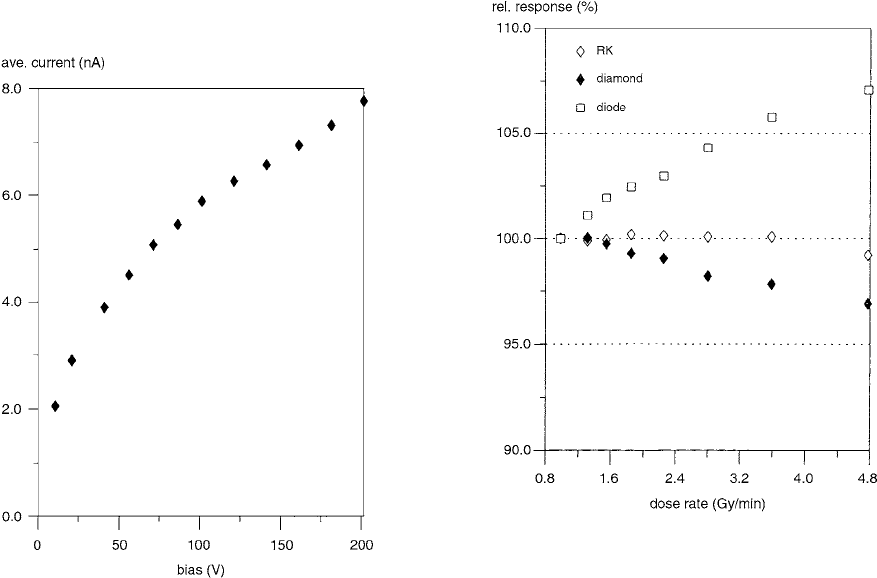
Solid-State Dosimeters
363
The current measured using a Nuclear Enterprises
2570 electrometer (with bias supplied externally) for bias
voltages of 20–200 V, at a dose rate of 2.0 Gy min
1
, is
shown in Figure 8.3. The current plotted is the charge
collected for a dose of 1.0 Gy divided by the irradiation
time of 30 s.
The charge collection efficiency is the ratio of detector
current to the rate at which charge is produced in ioniza-
tion (gain factor). The rate of charge production in the
crystal is readily calculated from knowledge of the dose
rate
D
, density
r
, and volume
V
of the sensitive element,
and the energy
w
required to produce an ion pair:
(8.1)
The density of diamond is 3.5 g cm
3
, the volume of the
crystal was 1.4
10
3
cm
3
, and
w
is approximately 16 eV,
so at a dose rate of 2.0 Gy min
1
(3.3
10
5
J g
1
s
1
),
the charge production rate is 1.0
10
8
C s
1
. From
Figure 8.3, the detector current at 2.0 Gy min
1
, with a
bias of 100 V, is 5.8
10
9
A, which gives a gain factor
of 0.58.
Dose-rate dependence measurements were made with
the RK ionization chamber, diode, and diamond. Results
are plotted in Figure 8.4, where it is seen that the relative
response of the diamond appears to be the same as the
ionization chamber for dose rates up to approximately
1.5 Gy min
1
and then decreases steadily as the dose
rate increases. In contrast to the findings of Rikner [3],
the diode shows a relatively large increase in over-response
as dose rate increases.
The suitability of diamond detectors has been inves-
tigated by Seuntjens et al. [4] to measure relative central-
axis depth kerma curves in medium-energy x-rays by
comparing them to the NE2571 cylindrical ionization
chamber. To investigate their limit of application in terms
of energy dependence, two diamond detectors were first
calibrated in terms of air-kerma free in air using free-air
ionization chambers for several low-and medium-energy
x-ray qualities. Energy dependence correction factors were
used to convert depth signal curves measured with a
diamond detector into depth kerma curves and to com-
pare them to curves measured using the well character-
ized NE2571 ionization chamber. The results show that
the diamond detector is directly suitable for relative dosim-
etry of medium-energy x-rays with qualities higher than
or equal to 100 kV (HVL 4.8-mm Al) to within 2% depth
dose. For lower x-ray qualities (down to 80 kV, HVL
2.6-mm Al), relative energy dependence correction factors
FIGURE 8.3
Average diamond detector current in nA vs. bias
voltage for a dose rate of 2.0 Gy min
1
. Current is the stable
electrometer reading in nC for a dose of 1.0 Gy divided by the
irradiation time of 30 s. (From Reference [2]. With permission.)
dQ
dt
-------
DV
e
w
---------------
FIGURE 8.4
Response of diamond, diode, and RK ionization
chamber as average dose rate varies from 0.98 to 4.77 Gy min
1
by changing FSD from 140 cm to 60 cm. Dose per pulse varies
from 0.079 to 0.387 mGy. Values on the graph are the ratio of
each detector reading to Farmer ionization chamber reading,
normalized to 100% at 0.98 Gy min
1
. (From Reference [2].
With permission.)
Ch-08.fm Page 363 Friday, November 10, 2000 12:03 PM
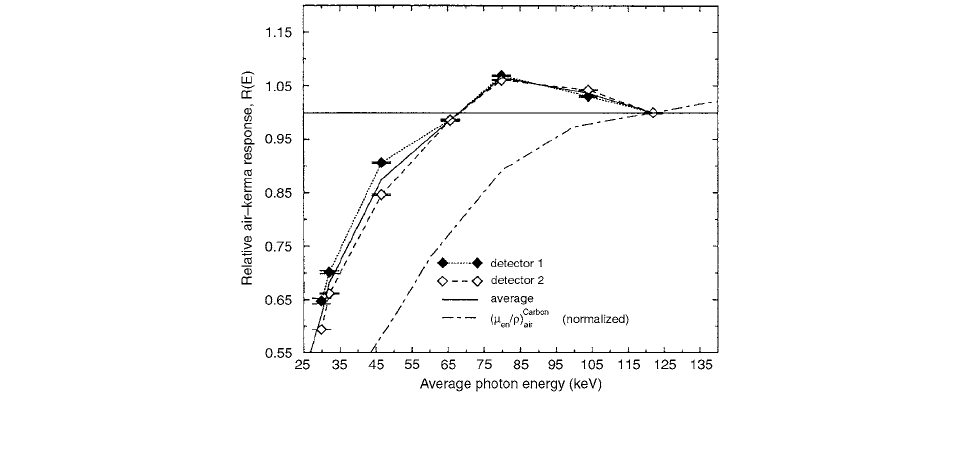
364
Radiation Dosimetry: Instrumentation and Methods
of at most 12% of the kerma value are necessary at a
depth of 10 cm when normalized to the response near the
phantom surface.
The diamond detector types used by Seuntjens were
from PTW (type Riga). The radiation-sensitive region of
the diamond detector is a low-impurity natural diamond
plate of thickness specified between 0.1 and 0.3 mm,
sealed in a cylindrical polystyrene housing of diameter
7.3 mm. The surface of the diamond is 1 mm beneath the
outer surface of the housing. As part of the irradiation
procedures, for each energy, the detectors were first pre-
irradiated up to an accumulated dose of at least 3 Gy as
determined by studying their response stability. Two dia-
mond detectors (PTW type Riga) were involved in relative
air-kerma calibrations against free-air chambers.
Figure 8.5 shows the response curves normalized to
1 at the radiation quality with average photon energy of
121.9 keV. The response exceeds unity by up to 6% for
average photon energy of 80 keV, presumably due to the
high
Z
materials involved in biasing the diamond chip.
Below 80 keV it gradually drops off, down to 65% of
the response at 29 keV, primarily due to photon attenu-
ation in the high-density chip. The differences between
the two PTW detectors in the decreasing portion of the
response curve are due to differences in chip thicknesses.
For the purpose of evaluating the quality correction factor,
the responses of both detectors were averaged. Also
shown in Figure 8.5 (dashed-dotted line) are the ratios of
mass energy absorption coefficients graphite to air, nor-
malized at the same energy (121.9 keV).
A PTW Riga diamond detector has been evaluated
by Heydarian et al. [5] for use in electron beam dosimetry,
by comparing results with those obtained using a diode
(Scanditronix p-Si) and an ionization chamber (Scan-
ditronix RK). The directional response of the diamond at
6 MeV and 15 MeV is more uniform than that of the
diode, but for both detectors there is a dip in response
when the beam axis is perpendicular to the detector stem.
Spatial resolution of the diode detector, measured beneath
a 2-mm-wide slit, is slightly better than that of the dia-
mond detector with detector stems both parallel and per-
pendicular to the beam axis. Diamond and diode depth-
dose curves both agree well with corrected ionization
chamber results at 15 MeV, while at 6 MeV the diamond
is in better agreement. This indicates that the diode pro-
vides better spatial resolution than the diamond for mea-
suring profiles, but the diamond is preferable for low-
energy depth-dose measurements.
Silicon diode detectors have the advantage of a small,
high-density, sensitive volume and thus have a high spatial
resolution. A significant disadvantage in principle, however,
is the non-water-equivalence of the silicon. As Figure 8.6
shows, the silicon:water collision-mass stopping power
ratio is not constant with electron energy, especially at
energies below 5 MeV (ICRU 37 [33]). In addition, sepa-
rate diode detectors are required for electron and photon
do-simetry.
The diamond detector is attractive because of its
near water-equivalence and its high spatial resolution.
As Figure 8.6 shows, the carbon:water stopping power
ratio remains approximately constant over the energy
range 1–20 MeV, which implies an advantage of dia-
mond detectors over silicon diodes for electron dosim-
etry. Figure 8.6 also shows the increase in the air:water
stopping power ratio with energy caused by the density
effect.
FIGURE 8.5
Relative air-kerma response of PTW diamond detectors measured against free-air ionization chambers. All results were
arbitrarily normalized to unity at an average photon energy of 121 keV. (From Reference [4]. With permission.)
Ch-08.fm Page 364 Friday, November 10, 2000 12:03 PM
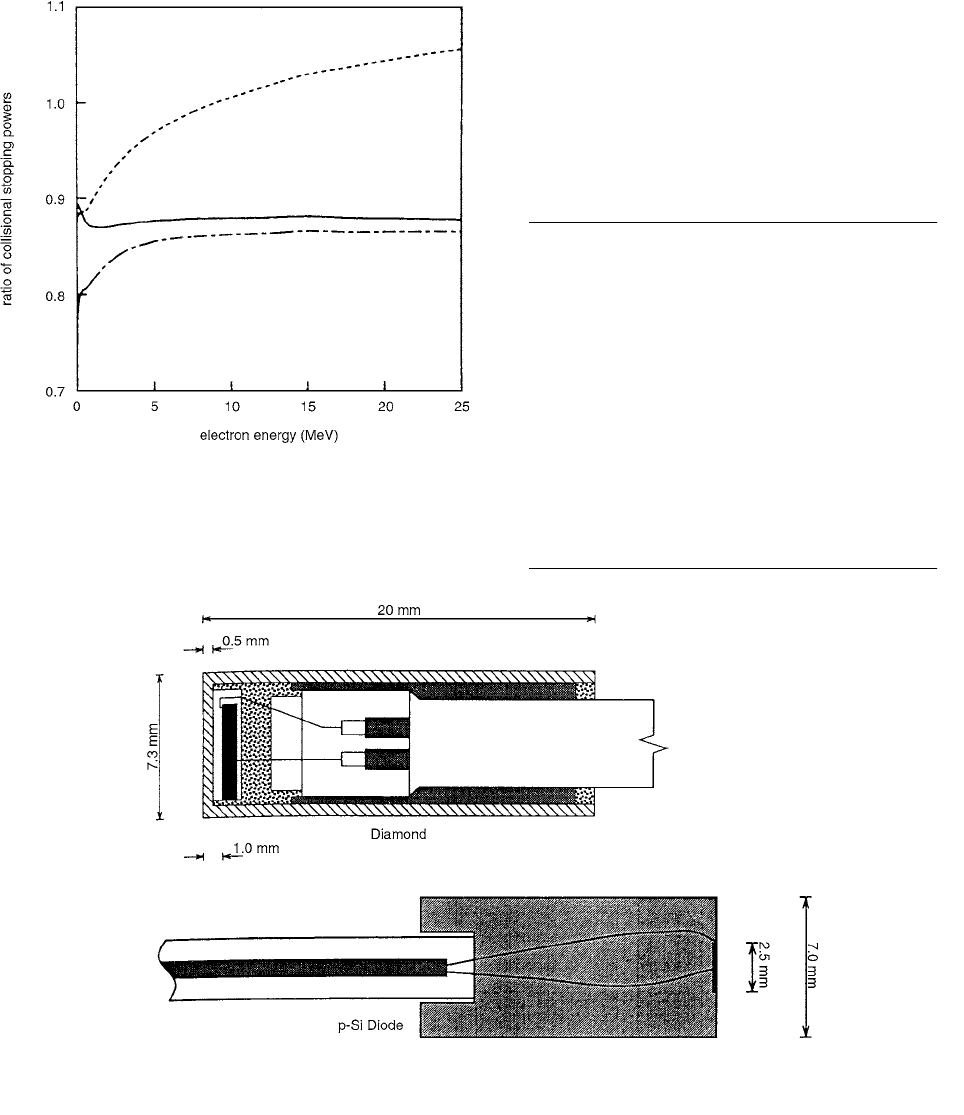
Solid-State Dosimeters
365
The sensitive region of the diamond detector is a low-
impurity natural diamond plate of thickness 0.33 mm and
volume 1.4 mm
3
, sealed in a cylindrical polystyrene hous-
ing of diameter 7.3 mm. An operating bias of
100 V
(recommended by PTW) is applied through 0.05–0.6-
m
gold contacts and 50-nm silvered copper wire. The surface
of the diamond plate is 1.0 mm beneath the end of the
housing. In Figure 8.7 a comparison of the longitudinal
cross sections of the diamond and diode detectors is shown.
Physical and operating parameters of the diamond detector
are given in Table 8.1. It should be noted that the mode
of operation of a diamond detector is as a resistive ele-
ment, where conductivity is proportional to dose rate.
The 6 MeV results are shown in Figure 8.8a, where
the readings at 0° are normalized to 100%. It can be seen
that the minimum in the diode detector response curve (at
approximately 100°) is less than that for the diamond
detector, while the maxima (at approximately 50°) are equal.
Results for a 15-MeV beam are shown in Figure 8.8b,
where again the minimum in the diode response is less
than that for the diamond. Note that for both detectors,
FIGURE 8.6
Collision stopping power ratios of carbon, air, and
silicon to water as a function of energy (from ICRU Report 37 [33]).
—, carbon:water; ----, air:water; — • —, silicon:water. (From
Reference [5]. With permission.)
TABLE 8.1
Physical Parameters of the Diamond Detector
(as Supplied by PTW).
Main impurities
Nitrogen and boron
(
10
19
atomis cm
3
)
Sensitive volume 1.4 mm
3
Sensitive area
4.3 mm
2
Thickness of sensitive volume
0.33 mm
Operating bias
1
00 V (
1%)
Dark current
10
12
A
Sensitivity to
60
Co radiation
1.75
10
7
C Gy
1
Pre-irradiation dose
5 Gy
From Reference [5]. With permission.
FIGURE 8.7
Longitudinal cross sections of the diamond detector and Scanditronix p-Si diode detector. The +100 V bias is applied
to the diamond through gold contacts on the diamond surface. (From Reference [5]. With permission.)
Ch-08.fm Page 365 Friday, November 10, 2000 12:03 PM
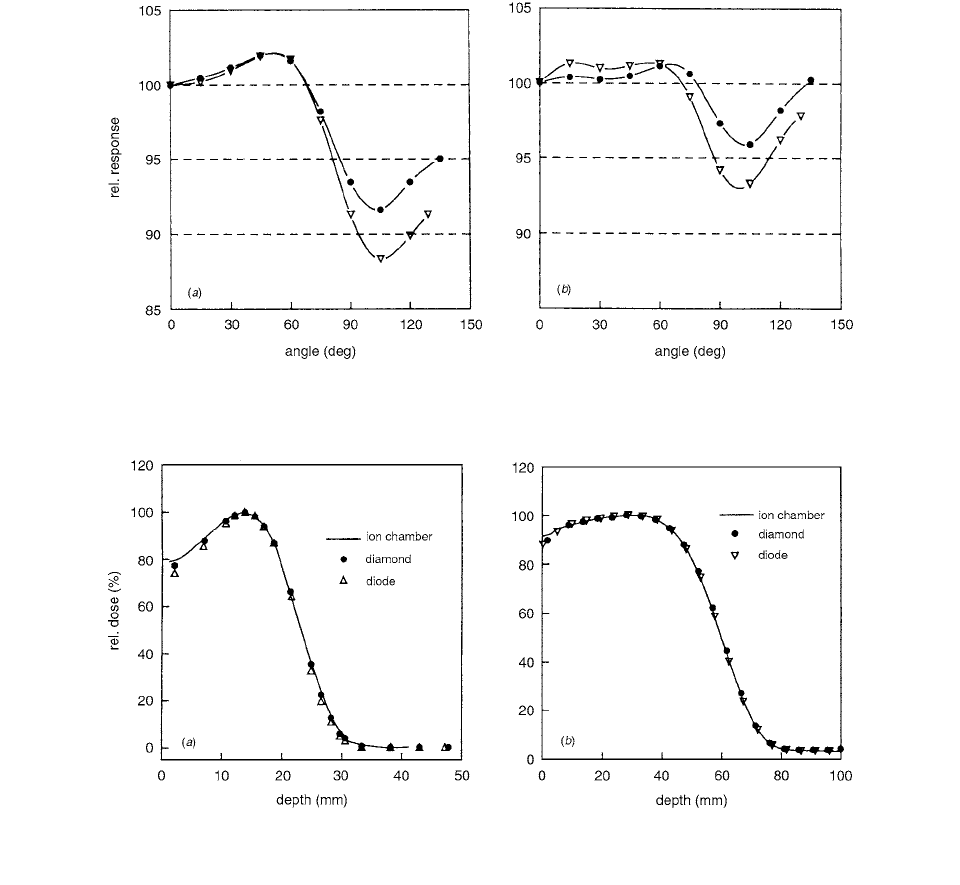
366
Radiation Dosimetry: Instrumentation and Methods
the curves are flatter at 15 MeV than at 6 MeV. The
variation in response with incident direction is probably
due to changing interface effects [3], where a varying
degree of delta-ray equilibrium is reached within the sen-
sitive volumes (ICRU 22 [34]).
In Figure 8.9a, a comparison between diamond, diode,
and ionization chamber results is shown for 6 MeV, where
the diamond and diode were both orientated parallel to
the beam. The effective points of measurement for the
diamond and diode are 1.00 mm and 0.5 mm beneath the
end of the detector housings, respectively.
Depth-dose curves for 15 MeV are shown in Figure 8.9b,
where it can be seen that the diode detector result is in
closer agreement with the diamond detector and ionization
chamber results than is the case for 6 MeV; this is because
the silicon-water stopping power ratio becomes almost
constant above 5 MeV (see Figure 8.6). Note that the depth
scale in Figure 8.9b is smaller than that of Figure 8.9a;
any deviation from the ionization chamber curve is there-
fore more noticeable for the 6-MeV curve.
Characteristics of the PTW/RIGA diamond detector
are: [6]
The diamond detector has the advantage of excellent
spatial resolution, low energy and temperature dependence,
high sensitivity, high resistance to radiation damage, and
almost no directional dependence. The diamond detector
is used for relative dosimetry, and it is typically used for
dose and dose-rate measurements in high-energy photon
and electron beams, where the fields are very small or
have steep gradients.
Technical Details
of the diamond detector are as
follow:
FIGURE 8.8
Directional response of the diamond and diode detectors for (a) 6 MeV and (b) 15 MeV. •, diamond;
, diode. (From
Reference [5]. With permission.)
FIGURE 8.9
Depth-dose curves as measured with the diamond and diode detectors in the parallel orientation, compared with
corrected ionization chamber results for (a) 6-MeV and (b) 15-MeV beams. (From Reference [5]. With permission.
Ch-08.fm Page 366 Friday, November 10, 2000 12:03 PM
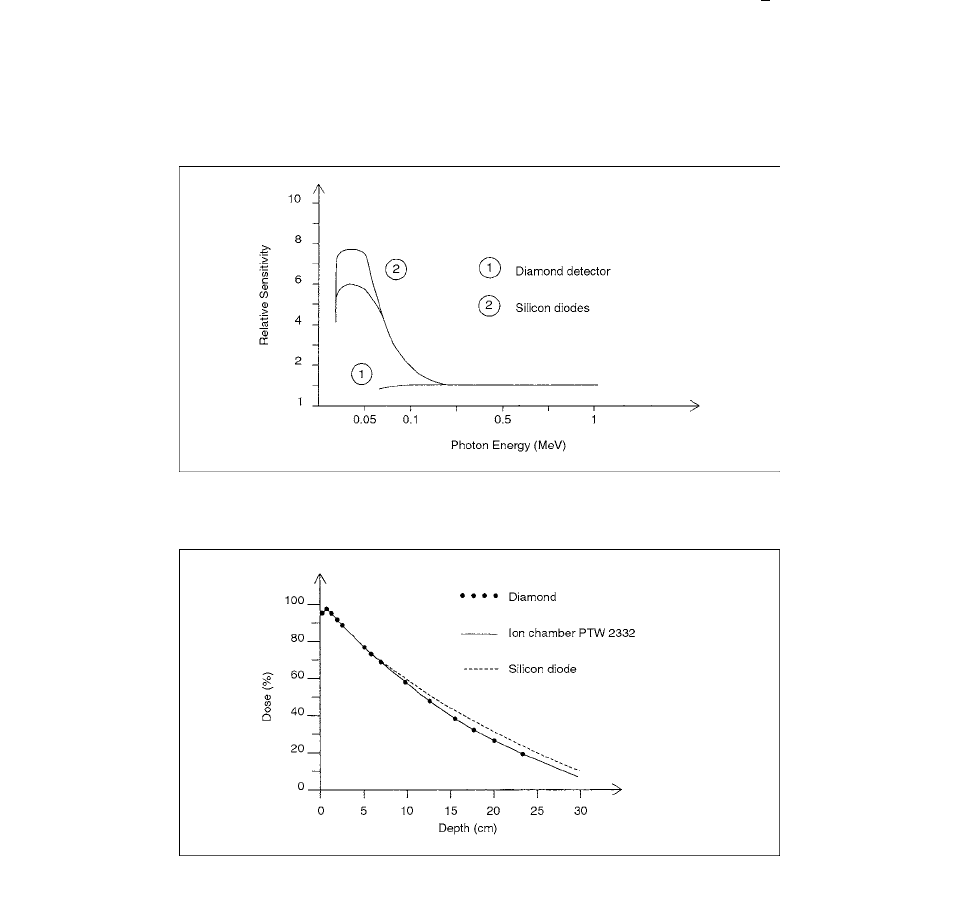
Solid-State Dosimeters
367
• Photon energy range: 0.08–20 MeV
• Electron energy range: 4–20 MeV
• Dose-rate range: 0.05–30 Gy/min
• Linearity of response:
2%
• Pre-irradiation dose: 5–10 Gy
• Operating bias:
100 V
1%
• Sensitivity to
60
Co radiation: 0.5–5.0
10
7
C/Gy (Figure 8.10)
• Dark current:
5
10
12
A
• Charge collection time:
10
8
s
• Sensitive area: 3–15 mm
2
• Thickness of sensitive volume: 0.1–0.4 mm
• Sensitive volume: 1–6 mm
3
• Radiation resistance:
10
5
Gy
• Outer probe diameter: 7.3 mm
• Weight incl. cable and connector: approx. 170 g
• Directional dependence: less than 2% in the
range of 0° to 170° in a water phantom for
depths larger than
d
max
(
d
max
depth of dose
maximum) (Figure 8.13)
60
Co and 15 MeV electron depth dose distributions are
shown in Figures 8.11 and 8.12, respectively.
Since the diamond detector uses a naturally grown
diamond, the exact dimensions of the sensitive volume
slightly differ. The exact data of each individual probe are
specified in the calibration certificate.
The absorbed dose to muscle from proton beam
charge measurements, using the
60
Co absorbed dose
calibrated detectors and proton beam quality correction
factor was proposed by Vatnitsky et al. [7] According
to modified cavity theory, the diamond detector can be
considered a carbon cavity in a water phantom when
exposed in a proton beam. The absorbed dose proton
beam quality correction factor for the diamond detector,
k
Qp
(
DD
), can be calculated by
(8.2)
k
QP
DD()
W
pr,carbon
e
W
,carbon
e
-------------------------
S
()
carbon
m
[]
pr
L
()
carbon
m
[]
cobalt
--------------------------------------
p
carbon
polyst
()
pr
p
carbon
polyst
()
cobalt
----------------------------
FIGURE 8.10
Relative photon sensitivity. (From Reference [6]. With permission.)
FIGURE 8.11
60
Co depth dose curve. (From Reference [6]. With permission.)
Ch-08.fm Page 367 Friday, November 10, 2000 12:03 PM
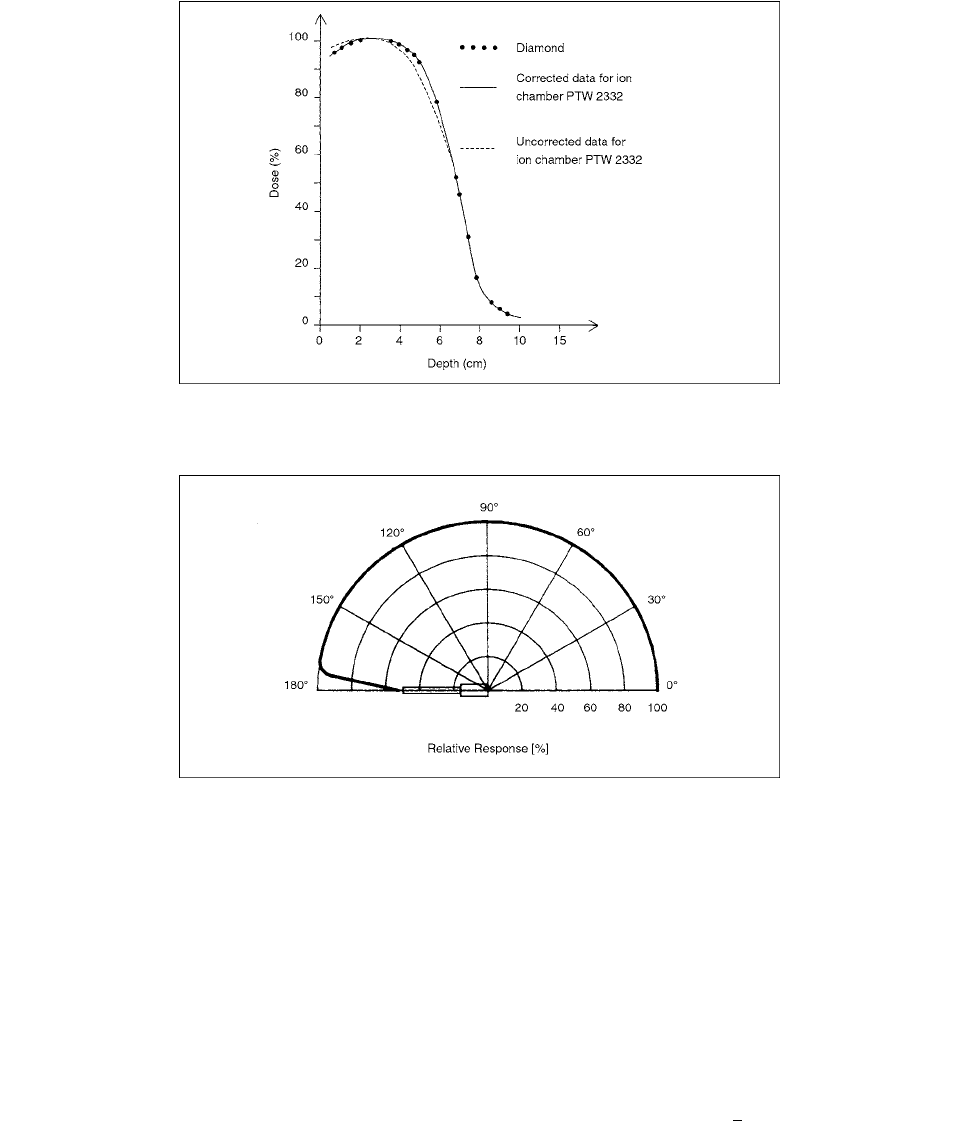
368
Radiation Dosimetry: Instrumentation and Methods
They assumed that the energy to produce an electron-
hole pair in a diamond detector is independent of the
energy and type of the particles. A second assumption is
that the diamond detector can be considered a thin disk-
shaped detector. In a proton beam, the scattering effect
can be considered negligible since the large mass of a
proton results in similar in-scattering and out-scattering
from the detector’s volume. Secondary electrons produced
in proton-electron collisions have an average range on the
order of several microns. It was assumed that all of the
ionization in a diamond plate is produced by these elec-
trons and some primary protons. There is a fraction of
delta-rays produced in proton-electron interactions with a
range comparable to the pathlength through the detector’s
volume, but the contribution of this component to the total
ionization is small compared with secondary electrons and
primary protons. It is estimated that perturbation effects for
the diamond detector in proton beams can be considered to
be at least smaller than in an electron beam, with their ratios
safely assumed equal to unity. The uncertainty for this
assumption was estimated at 0.5%, resulting in a total
uncertainty for the perturbation factors ratios of
0.7%.
With the two above-stated assumptions, Equation (8.2)
can be rewritten for diamond detectors that have
60
Co
absorbed dose to polystyrene calibration factors as fol-
lows:
(8.3)
The mass energy absorption ratio of carbon to water
is nearly constant over a wide energy range, making the
diamond detector nearly tissue-equivalent. The direc-
tional dependence of the radiation response of the dia-
mond detector for
60
Co 6-MV and 18.MV photon beams
FIGURE 8.12
15-MeV electron depth dose curve. (From Reference [6]. With permission.)
FIGURE 8.13
Directional response. (From Reference [6]. With permission.)
k
QP
DD()
S
()
carbon
m
[]
pr
L
()
carbon
polyst
[]
cobalt
--------------------------------------
Ch-08.fm Page 368 Friday, November 10, 2000 12:03 PM
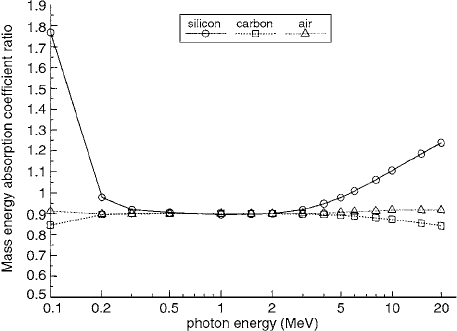
Solid-State Dosimeters
369
was found by Rustgi [8] to be more uniform than that
of the diode. The spatial resolution of the diamond detec-
tor, as measured by penumbra width, is slightly less than
that of the diode detector but clearly superior to that of
the 0.14-cm
3
ionization chamber. The diamond detector,
with high radiation sensitivity and spatial resolution, is
an excellent choice as a detector in photon fields with
high dose gradients such as brachytherapy and radiosur-
gery. [8]
A commercially available diamond detector (PTW)
was evaluated by Rustgi. The diamond detector had a
small measuring volume of 1.9 cm
3
with a sensitive area
of 7.3 mm
2
and a plate thickness of 0.26 mm. As shown
in Figure 8.7, the detector is enclosed in a cylindrical
plastic housing with the natural diamond plate displaced
1 mm below the front circular face of the housing. For
optimum operation, a bias of
100 V from an external
source was applied to the detector, as recommended by
the manufacturer. The conductivity induced in the dia-
mond plate by irradiation is directly proportional to the
dose rate. The charge produced in the diamond plate was
measured with a Keithley 35614 electrometer with its
electronic bias grounded. In order to stabilize the response
of the diamond detector, it was irradiated to a dose of 500
cGy, as suggested by the manufacturer.
After stabilizing the response of the diamond detec-
tor by irradiating it to a dose of 500 cGy in a solid water
phantom, the maximum variation of the diamond detec-
tor response was found to be less than 0.5% over an 8-h
period. The radiation sensitivity of the diamond detector
was measured to be approximately 2.2
10
9
C cGy
1
,
compared to 1.0
10
9
C cGy
1
for the photon diode
under identical irradiation geometries. The diode detector
has a sensitive volume of 0.3 mm
3
, compared to 1.9 mm
3
for the diamond detector.
The mass energy absorption coefficients of carbon, air,
and silicon relative to water as a function of photon energy
are shown in Figure 8.14. The mass energy–absorption
coefficient ratio of carbon to water changes by less than
7%, compared to 42% for the silicon to water ratio in the
0.1–20 MV energy range. Measurements made with a
silicon diode detector require energy-dependent correction
factors to convert diode response to dose.
Energy and dose rate dependence of a diamond detec-
tor in the dosimetry of 4–25-MV photon beams has been
measured by Laub et al. [9] The diamond detector was a
low-impurity natural diamond plate of thickness 0.032 cm
and volume 0.003 cm
3
. It was connected to a Unidos
Universal Dosimeter (PTW- Freiburg) with an applied
detector bias of
100 V. Dose measurements were carried
out in an MP3-water phantom (PTW-Freiburg). The dia-
mond detector was positioned on the central axis of a
photon beam, entering the surface of the water phantom
perpendicularly.
The diamond detector’s response turned out to be
slightly decreasing with increasing dose rate. This is actu-
ally to be expected from the theory of radiation-induced
conductivity in an insulator, which explains the decrease
in response as a consequence of a very short electron-hole
recombination time. The alteration of detector current with
increasing dose rate can be approximated by the empirical
expression
(8.4)
where
i
is the detector current and is the dose rate. The
parameter
i
dark
indicates dark-current influences and is
consequently nearly zero.
R is a fitting parameter for the
response of the diamond detector, and is one for the
slight sublinearity of response. In this examination,
turned out to be 0.963 0.005.
The response of the diamond detector, indicated by
the fitting parameter R, was established at different levels
of photon energy. The detector’s response did not change
significantly at any stage; consequently, the diamond
detector shows no energy dependence within the covered
energy range of 4–25 MV (Figure 8.15). Although this is
to be expected due to the near tissue equivalence of carbon,
the contact material of the detector might introduce an ele-
ment of energy dependence. Heydarian et al. [5], exposing
a diamond detector to a 6- and a 15-MeV electron beam,
could not find any energy dependence requiring correc-
tion. According to Laub results, this holds true for high-
energy photon beams, as well. The error bars inserted in
Figure 8.15 principally correspond to variations in the
dose rate delivered by the accelerator. The diamond detec-
tor was also found to possess a superior spatial resolution
and a high sensitivity (about 4.1 10
7
C-Gy
1
). [9]
FIGURE 8.14 Mass energy attenuation coefficients of carbon,
air, and silicon relative to water as a function of photon energy.
(From Reference [8]. With permission.)
ii
dark
RD
˙
D
˙
Ch-08.fm Page 369 Friday, November 10, 2000 12:03 PM
